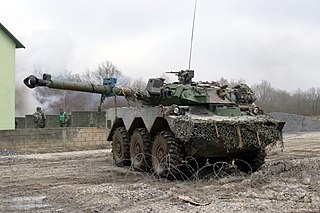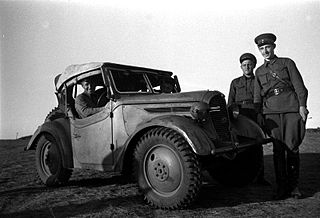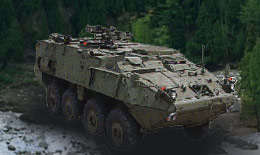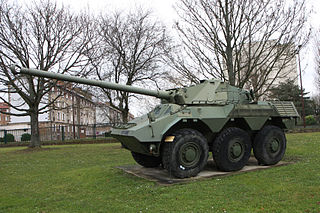 W
WAEC Armoured Car is the name of a series of British heavy armoured cars built by the Associated Equipment Company (AEC) during World War II.
 W
WThe FV601 Saladin is a six-wheeled armoured car developed by Crossley Motors and later manufactured by Alvis. Designed in 1954, it replaced the AEC Armoured Car in service with the British Army from 1958 onward. The vehicle weighed 11 tonnes, offered a top speed of 72 km/h, and had a crew of three. Saladins were noted for their excellent performance in desert conditions, and found favour with a number of Middle Eastern armies accordingly. They were armed with a 76 mm low-pressure rifled gun which fired the same ammunition as that mounted on the FV101 Scorpion.
 W
WThe AMX-10 RC is a reconnaissance vehicle built by GIAT. Over 240 are in service in the French Army. In addition, 108 vehicles were sold to Morocco and 12 to Qatar. RC stands for Roues-Canon, or wheeled gun.
 W
WThe Armoured Multi Purpose Vehicle (AMPV) is a well-protected light armoured 4×4 vehicle that has been developed as a joint venture between Germany's Rheinmetall MAN Military Vehicles (RMMV) and Krauss-Maffei Wegmann (KMW). It was developed for the German Army's Protected Command and Function (GFF) Group 2 requirement.
 W
WThe BA-64 was a Soviet four-wheeled armoured scout car. Built on the chassis of a GAZ-64 or GAZ-67 jeep, it incorporated a hull loosely modeled after that of the Sd.Kfz. 221. The BA-64 was developed between July and November 1941 to replace the BA-20 then in service with armoured car units of the Red Army. Cheap and exceptionally reliable, it would later become the most common Soviet wheeled armoured fighting vehicle to enter service during World War II, with over 9,000 being manufactured before production ended.
 W
WThe BRDM-2 is an amphibious armoured patrol car used by Russia and the former Soviet Union. It was also known under the designations BTR-40PB, BTR-40P-2 and GAZ 41-08. This vehicle, like many other Soviet designs, has been exported extensively and is in use in at least 38 countries. It was intended to replace the earlier BRDM-1, compared to which it had improved amphibious capabilities and better armament.
 W
WThe BTR-40 is a Soviet non-amphibious, wheeled armoured personnel carrier and reconnaissance vehicle. It is often referred to as the Sorokovka in Soviet service. It is also the first mass-produced Soviet APC. It was eventually replaced in the APC role by the BTR-152 and in the scout car role by the BRDM-1.
 W
WThe D-442 FUG and D-944 PSZH are the results of Hungarian domestic development of relatively cheap amphibious armoured scout car and armored personnel carrier series. FUG and PSZH were exported with limited success, thus it is also known under its Czechoslovak designation OT-65.
 W
WThe Daimler Scout Car, known in service as the Daimler Dingo, was a British light fast four-wheel drive reconnaissance vehicle also used for liaison during the Second World War.
 W
WThe Dozor-B is a four-wheeled Ukrainian armored car.
 W
WThe EE-3 Jararaca is a Brazilian scout car developed for route reconnaissance, liaison, and internal security purposes. It was engineered by Engesa in response to a perceived Brazilian Army requirement for a light armored car capable of replacing its unarmored utility vehicles in the liaison and security role. The first Jararaca prototype appeared in 1979 and serial production commenced in 1982 after extensive operational testing in Brazil. It was ultimately rejected for large scale service with the Brazilian Army due to concerns over the limited mobility of its four-wheeled chassis but achieved some minor successes on the export market.
 W
WThe EE-9 Cascavel is a six-wheeled Brazilian armoured car developed primarily for reconnaissance. It was engineered by Engesa in 1970 as a replacement for Brazil's ageing fleet of M8 Greyhounds. The vehicle was first fitted with the Greyhound's 37mm main gun, and subsequently, a French turret adopted from the Panhard AML-90. Later models carry unique Engesa turrets with a Belgian 90mm Cockerill Mk.3 cannon produced under licence as the EC-90.
 W
WThe Eland is an air portable light armoured car based on the Panhard AML. Designed and built for long-range reconnaissance, it mounts either a 60mm (2.4 in) breech-loading mortar or a Denel 90mm (3.5 in) gun on a very compact chassis. Although lightly armoured, the vehicle's permanent 4X4 drive makes it faster over flat terrain than many tanks.
 W
WThe EBRC Jaguar is a French armored reconnaissance and combat vehicle that will replace the French Army's VCAC, AMX 10 RC and ERC 90 Sagaie reconnaissance and fire support vehicles.
 W
WThe Panhard ERC is a French six-wheeled armoured car which is highly mobile and amphibious with an option of being NBC-proof. While various models were tested, only two versions of the ERC entered production in large numbers: the ERC-90 Lynx and the ERC-90 Sagaie. The main difference between the two versions is the type of turret and 90 mm gun fitted. Sagaie is French for assegai, a type of African spear.
 W
WThe Ferret armoured car, also commonly called the Ferret scout car, is a British armoured fighting vehicle designed and built for reconnaissance purposes. The Ferret was produced between 1952 and 1971 by the UK company Daimler. It was widely adopted by regiments in the British Army, as well as the RAF Regiment and Commonwealth countries throughout the period.
 W
WThe Komatsu light armored vehicle (Japanese: 軽装甲機動車; is a Japanese military vehicle first produced in 2002. Currently used exclusively by the Japan Self-Defense Force, it has seen use in the Iraq War. It is built by Komatsu Ltd. Defense Systems Division in Komatsu, Ishikawa, Japan. Komatsu's factory designator for the vehicle is KU50W.
 W
WThe Type 95 was a Japanese scout car built by Tokyu Kurogane Industries , and was used during the war with China and World War II in the East. Between 1936 and 1944 approximately 4,700 were built. It was the only completely Japanese designed reconnaissance car ever used by the Imperial Japanese Army, which tended to use civilian cars. Its nickname is the "Yonki" (よんき) which in Japanese means "all-wheel drive". In the field, soldiers often called it the "daruma" after the Buddhist symbol for good luck.
 W
WThe LAV-25 is an eight-wheeled amphibious armored reconnaissance vehicle built by General Dynamics Land Systems and used by the United States Marine Corps and the United States Army.
 W
WThe Daimler Scout Car, known in service as the Daimler Dingo, was a British light fast four-wheel drive reconnaissance vehicle also used for liaison during the Second World War.
 W
WThe Pantserwagen M39 or DAF Pantrado 3 was a Dutch 6×4 armoured car produced in the late thirties for the Royal Dutch Army.
 W
WThe M1127 Reconnaissance Vehicle is a wheeled armored personnel carrier in the Stryker family. It is in service with the US Army.
 W
WThe Fire Support Vehicle (FSV) of the Stryker series provides automated enhanced surveillance, target acquisition, target identification, target tracking, target designation, position location and communications functionality. Targets will be transmitted instantly to the fire support system and shooter.
 W
WThe M1135 Nuclear, Biological, Chemical Reconnaissance Vehicle (NBCRV) provides nuclear, biological and chemical detection and surveillance for battlefield hazard visualization.
 W
WThe Panhard AML is a fast, long-ranged, and relatively cheap armoured car with excellent reconnaissance capability. Designed on a small, lightly armoured 4×4 chassis, it weighs an estimated 5.5 tonnes—much lighter than a tank—and is therefore more suited to rapid airborne deployments. Since 1959 AMLs have been marketed on up to five continents; several variants remained in continuous production for half a century. These have been operated by fifty-four national governments and other entities worldwide, seeing regular combat.
 W
WThe Sd.Kfz. 234, was a family of armoured cars designed and built in Germany during World War II. The vehicles were lightly armoured, armed with a 20, 50 or 75 mm main gun, and powered by a Tatra V12 diesel engine. The Sd.Kfz. 234 broadly resembles the appearance of Sd.Kfz. 231 .
 W
WThe Spähpanzer Luchs is a German 8x8 amphibious reconnaissance armoured fighting vehicle (Spähpanzer) was in service from 1975 to 2009 with the German Army, who used 408 in their armoured reconnaissance battalions. It was developed by Daimler-Benz between 1968 and 1975, replacing the M41 and the Schützenpanzer SPz 11-2 Kurz.
 W
WThe Type 87 Reconnaissance and Patrol Vehicle, also known as Burakkuai or Type 87 ARV for short, is a 6x6 wheeled Armoured Fighting Vehicle designed and manufactured by multinational heavy industry manufacturer Komatsu Limited and employed exclusively by the Japanese Ground Self-Defense Forces. The JGSDF continued to commission new units up until as recently as 2013
 W
WThe Renault VBC-90 is a six-wheeled French armoured car carrying a 90mm high-velocity gun mated to a sophisticated fire control computer and ranging system. It was developed primarily for internal security or armed reconnaissance purposes. Modeled after Renault's Véhicule de l'Avant Blindé (VAB) armoured personnel carrier, the VBC-90 was engineered in concert with Saviem and Creusot-Loire. One was also built in prototype form by Argentina under license, where it was known as the Vehículos de Apoyo y Exploración. VBC-90s were available with various chassis configurations resembling both the VAB and the Berliet VXB-170.
 W
WThe Pegaso VEC-M1 is a Spanish military cavalry reconnaissance vehicle. It started service in the Spanish Army in 1980 as BMR-625 VEC and all of them were upgraded in late 1990s to the M1 version.
 W
WThe Panhard Véhicule Blindé Léger, also known by its acronym Panhard VBL or simply VBL, is a French wheeled 4x4 all-terrain vehicle built by Panhard. The vehicle is offered in various configurations, and was designed to combine the agility of the Peugeot P4 liaison vehicle with adequate protection against small arms fire, artillery fragments, mines and NBC weapons. Produced between 1985 and 2010, the vehicle has been used by the French Army and other European, African and Central American armies in various conflicts since the 1980s.